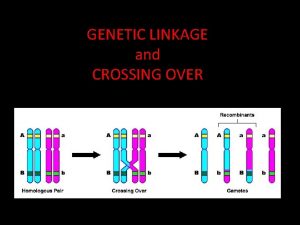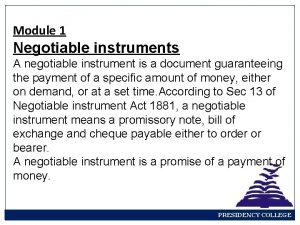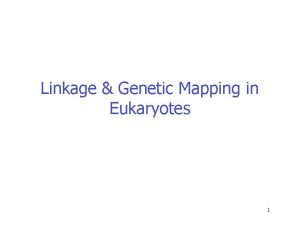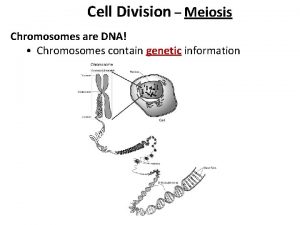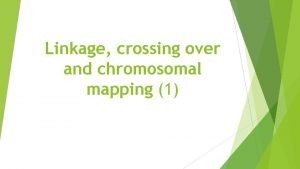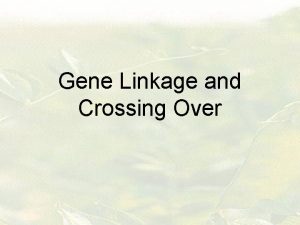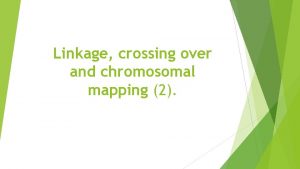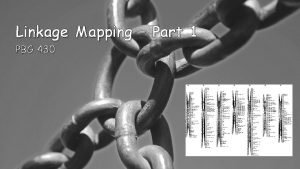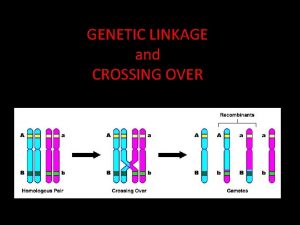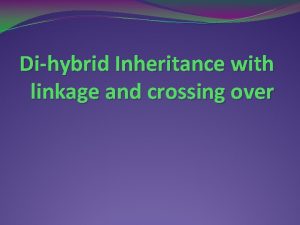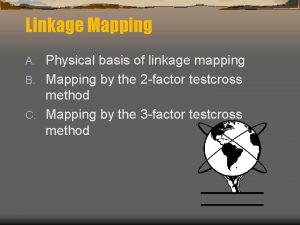Linkage crossing over and chromosomal mapping 1 Linked










- Slides: 10

Linkage, crossing over and chromosomal mapping (1)

Linked genes sit close together on a chromosome, making them likely to be inherited together Genes on separate chromosomes are never linked Genes that are further away from each other are not linked, because more likely to be separated during a process called homologous recombination

Homologues chromosomes A chromosome is a single piece of DNA. Genes are segments of DNA arranged along a chromosome. A single chromosome can have hundreds or even thousands of genes. Homologous chromosomes have the same genes arranged in the same order, but they have slightly different DNA sequences. Different versions of the same gene are called alleles. Homologous chromosomes often contain different alleles. Alleles are important because they account for the differences in inherited characteristics from one individual to another. For example, different alleles of the same genes can make our eyes blue , green. Same genes, same orders

Crossing over (homologous recombination) Crossing over allows alleles on DNA molecules to change positions from one homologous chromosome segment to another. And it is responsible for genetic diversity in a species or population. Crossing over happens during prophase I of meiosis in sex cell production.

The duplicated pairs of chromosomes (sister chromatids) derived from each parent line up closely together forming what is called a tetrad. A tetrad is composed of four chromatids. Tetrad Chiasma As the two sister chromatids are aligned in close proximity to one another, one chromatid from the maternal chromosome can cross positions with a chromatid from the paternal chromosome, these crossed chromatids are called a chiasma.

Crossing over that occurs in nonhomologous chromosomes cause a type of chromosome mutation known as a translocation. A translocation happens when a chromosome segment separates from one chromosome and moves to a new location on another non-homologous chromosome (some times happened during egg and sperm development). This type of mutation often leads to the development of cancer cells

Two main types of translocation: 1 - a Reciprocal translocation: Swap places form two different fragments from different chromosome. Often, there is loss of DNA at the break point that is too small to be detected. but rarely may interrupt a gene and cause a phenotype.

2 - Robertsonian translocation: Two whole chromosomes stuck together. A Robertsonian translocation effects acrocentric chromosomes fuse together. This fusing joins two “long arms” of DNA into one. Loss of the short arms of two acrocentric chromosomes is not harmful and individuals with this type of rearrangement are generally phenotypically normal. Common translocation formations include: 1 - chromosome 13 with chromosome 2 - chromosome 13 with chromosome 3 - chromosome 14 with chromosome 4 - chromosome 15 with chromosome 5 - chromosome 21 with chromosome 14. 21. 21. 22.

Balanced translocation: Not lost of genetics material. Most of time, they are perfectly healthy. May inherit unbalanced translocation to their children Unbalanced translocation: Extra piece of chromosome either missing (deletion) or duplicate (insertion). Having little of too much genetics material tends to cause health problem.

Two available tests to check chromosomes during pregnancy Amniocentesis: Chorionic villus sampling (CVS) : Collect a small amount of the fluid around developing baby (amniotic fluid), which has cells from the baby. Possible around 16 weeks. Collect a small amount of the baby’s developing placenta. Possible around 10 -11 weeks
 Pbg idstein
Pbg idstein Bootstrap loaders
Bootstrap loaders Sans recourse endorsement
Sans recourse endorsement Chi square test for linkage
Chi square test for linkage In linked list the successive elements
In linked list the successive elements Difference between an array and a linked list
Difference between an array and a linked list Perbedaan single linked list dan double linked list
Perbedaan single linked list dan double linked list Mitosis vs meiosis chart
Mitosis vs meiosis chart Concept map of cell cycle mitosis and meiosis
Concept map of cell cycle mitosis and meiosis Crossing over in meiosis and mitosis
Crossing over in meiosis and mitosis Over center linkage
Over center linkage
